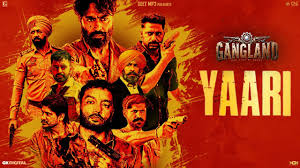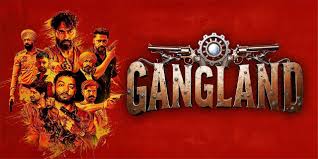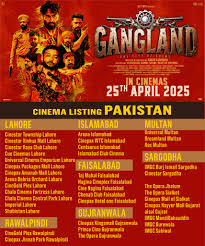Gangland
1. Introduction
Gangland: The City of Crime (shortened to Gangland) is a bold, gritty Punjabi-language action crime drama released in 2025, directed and written by Savio Sandhu, and produced by KV Dhillon, Anmol Sahni, and Parteek Sharma BookMyShow+14Wikipedia+14OTTPlay+14. With a runtime of 127 minutes, the film unfolds in 1986 Punjab, chronicling the rise and fall of a violent robbery gang, the fracturing of a lifelong friendship, and the ensuing cycles of revenge that engulf individuals and communities Wikipedia+1Indian Community+1.
The film is a cinematic adaptation of the 2018 Punjabi web series “Gangland in Motherland” and is frequently compared to Gangs of Wasseypur for its raw realism, bleak atmosphere, and complex underworld politics punjabimania.com+5Wikipedia+5Indian Community+5.
2. Cast & Key Crew
- Director / Writer: Savio Sandhu WIRED+15Wikipedia+15Indian Community+15
- Producers: KV Dhillon, Anmol Sahni, Parteek Sharma
- Lead Cast: Sippy Gill (Sultan), Nishawn Bhullar (Hakam), Amiek Virk, Dheeraj Kumar, Kul Sidhu, Hobby Dhaliwal, Vadda Grewal, Harv Cheema, Devi Grewal, Paramveer Singh, Victor John Binged+11Wikipedia+11Indian Community+11

3. Production & Release
| Detail | Information |
| Production Budget | ₹8 Crore + ₹2 Crore P&A = ₹10 Crore total MT Wiki Blog |
| Theatrical Release | April 25, 2025 (India) WikipediaBinged |
| Runtime | Approximately 127 minutes BBFCFandango |
| Certification | U/A (for violence & mature themes) Indian CommunityBBFC |
| OTT Release | July 24, 2025 on Chaupal and OTTplay Premium Home | Mobile MasalaOTTPlay |
Box office performance was modest: total gross of ₹1.24 Crore worldwide, about ₹1.11 Crore net in India, well below the budget threshold of ₹15 Crore needed to be considered a hit OTTPlay+3MT Wiki Blog+3NewsroomPost+3.
4. Full Story Summary
4.1 Setting & Opening
The film opens in rural Punjab, 1986, introducing two childhood best friends—Sultan (Sippy Gill) and Hakam (Nishawn Bhullar)—who run a tight-knit six-member robbery gang. They primarily target rural villages, pulling off daring heists with meticulous planning The New Yorker+15Wikipedia+15Indian Community+15.
4.2 The Turning Point
Following a high-stakes robbery in a village, Sultan announces his intent to leave the criminal life behind. He yearns for a peaceful life: marriage, stability, escape from violence. Hakam, however, sees profit, power, and status tied to their criminal identity—and vehemently opposes Sultan’s decision Home | Mobile Masala+4Wikipedia+4OTTPlay+4.

4.3 Breaking of Brotherhood
Sultan’s decision fractures their partnership. A confrontation explodes into betrayal, splitting the gang into factions loyal to Sultan and those backing Hakam. This schism marks the start of a bitter feud, where trust dissolves and bullets replace friendship WikipediaIndian Community.
4.4 Escalation & Retaliation
As rivalries intensify, new gangs emerge, and battles for dominance flare up across villages and towns. Sultan forms alliances with local law-abiding figures; Hakam recruits hardened criminals, fueling gunfights, ambushes, and escalating vendettas. The narrative delves into collateral damage: civilians, family members, and rival gang members caught in the crossfire.
4.5 Personal Toll
Both former friends face personal consequences. Sultan’s desire for redemption clashes with the violent consequences of his past; Hakam grows increasingly paranoid, haunted by guilt and fear of betrayal. Supporting characters—like Kul Sidhu’s role and Hobby Dhaliwal’s—add emotional texture as victims, enforcers, and moral voices in the chaos.
4.6 Climax & Tragedy
In the final act, a full-scale showdown brings Sultan and Hakam face to face, amidst ruined homes, burned-out vehicles, and exhausted survivors. Their deepest wounds—loyalty, betrayal, regret—come to a head. Some members die gruesome deaths, others surrender or vanish. The film concludes with a haunting ambiguity: Sultan survives but is emotionally broken; Hakam faces downfall or arrest, leaving open whether forgiveness, redemption, or annihilation prevails.

5. Key Characters & Cast
- Sultan (Sippy Gill): Charismatic, strategic, torn between ambition and longing for peace. His retirement trigger is the emotional centerpiece.
- Hakam (Nishawn Bhullar): Ambitious, calculating, refuses to relinquish power. Their ideological clash drives the plot.
- Kul Sidhu, Hobby Dhaliwal, Vadda Grewal, Amiek Virk, Dheeraj Kumar: Each embodies allies or rivals—loyalists, enforcers, doubters—portraying the complexity of gang ecosystems Rotten Tomatoes+12Wikipedia+12BBFC+12.
- Ensemble support: Roles like Harv Cheema, Devi Grewal, Paramveer Singh, Victor John fill out the criminal and civilian world, adding emotional and thematic layers Fandango+5Home | Mobile Masala+5OTTPlay+5.
6. Themes & Tone
6.1 Brotherhood vs Betrayal
At its core: the betrayal of a lifelong friendship in the name of ambition. Sultan and Hakam’s bond is tested by greed, fear, and conflicting visions after their shared success.
6.2 Cycle of Violence
The film demonstrates how violence breeds violence, trapping all involved in an unending loop of retribution—villages burned, lives destroyed, innocence lost.
6.3 Moral Ambiguity
Protagonists are deeply flawed. Sultan, though likable, is still complicit. Hakam is charismatic yet brutal. The film avoids clear heroes or villains; instead shows shades of gray.
6.4 Gritty Visual & Auditory Tone
Shot with moody lighting, rustic Punjab landscapes, tight framing in alleys and hideouts. Soundtrack features rap tracks and atmospheric scoring. Dialogue by Gurpreet Bhullar is razor-sharp, capturing Punjabi underworld authenticity punjabimania.com+1Indian Community+1.
7. Music & Soundtrack
Three singles were released before the film:
- “Gangland: The City of Crime” by Guri Lahoria
- “Jail” by Labh Heera
- “City Gangland” by Deep Jandu and Mijaz BBFC+10Wikipedia+10Indian Community+10
The score (composed by Amar Mohile) underscores tense moments—shootouts, betrayals, confrontational dialogues. Rap-infused songs inject energy; the diegetic soundscape amplifies authenticity, adding to the film’s raw tone Bingedpunjabimania.com.
8. Critical Reception
Punjabi Mania called it “Punjabi action fans have been waiting for. Bold, brutal, unapologetically intense.” Praised were the performances of Vadda Grewal, Kul Sidhu, and Hobby Dhaliwal—their precision, attitude, and cinematic presence drove much of the emotional impact punjabimania.com.
Comparison to Gangs of Wasseypur appears in multiple reviews: gritty realism, moral complexity, rural setting, and explosive violence. The screenplay, pacing, and character arcs were widely acclaimed even when box office returns were modest Wikipedia.
The Indian Community reviewer Rachna Gupta awarded it ★★★★☆ (4/5), lauding direction by Savio Sandhu, cinematography, genre-blending action, and emotional depth—though noting pacing issues and some predictable plot familiarities Indian Community.
9. Box Office Performance
- Budget: Approx ₹10 Crore (₹8 Cr production + ₹2 Cr P&A) MT Wiki Blog
- India Net Gross: ₹1.11 Crore
- Worldwide Gross: ₹1.24 Crore
- Verdict: Did not reach ₹15 Crore benchmark; officially considered unsuccessful commercially despite critical praise MT Wiki Blog
Factors for limited commercial traction: niche Punjabi crime genre, limited marketing, regional distribution limits, and mature content restricting audience reach.
10. Streaming & Accessibility
The film made its OTT premiere on July 24, 2025, on Chaupal and OTTplay Premium. A subscription is required to access the thriller digitally Wikipedia+10Home | Mobile Masala+10NewsroomPost+10.
Interestingly, the original web series “Gangland in Motherland” (2018) was also made available on the same platform—viewers can compare series vs film storytelling arcs punjabimania.com+5Home | Mobile Masala+5Wikipedia+5.
11. Legacy & Significance
Though not a box office success, Gangland made waves in Punjabi cinema by pushing boundaries on content, style, and scale. It marked a shift from formulaic regional films to more ambitious, character‑driven crime dramas. Reviewers suggest it sets a new benchmark for Punjabi filmmakers exploring underworld themes and ensemble storytelling Indian Communitypunjabimania.com.
12. Strengths & Criticisms
Strengths:
- Performances: Powerful portrayals by Sippy Gill, Nishawn Bhullar, Kul Sidhu, Hobby Dhaliwal, Vadda Grewal with emotional weight Binged+12punjabimania.com+12Indian Community+12
- Atmosphere: Gritty visual style, realistic environments, intense action choreography Indian Communitypunjabimania.com
- Sound & Score: Pre-release singles and rap-infused soundtrack elevate tone Wikipediapunjabimania.com
Criticisms:
- Pacing: Certain sequences drag, detracting momentum Indian Community
- Predictability: Revenge loops and power plays feel familiar after early twists punjabimania.com
- Underdeveloped Minor Characters: Some supporting roles lack depth or emotional arcs Indian Community
13. Comparison to Related Works
The film’s structure and themes invite comparison to:
- Gangs of Wasseypur (Hindi crime saga)—similar rural criminal milieu, multi-generational feud, moral breakdown.
- Punjabi web series Gangland in Motherland—the film condenses key arcs into cinematic form, sacrificing episodic depth for pacing and cinematic scale.
- Other regional gangster stories: echoes of narrative structure in films like Subhraj or Shooter, but with more emotional ambition.
14. Why It Matters
- Regional Cinema Evolution: Gangland elevated Punjabi cinema by exploring antiheroes, graphic violence, and complex dialogues—not just family dramas or comedies.
- Style & Substance: Balances stylized action with grounded performances and social commentary.
- Talent Showcase: Offered breakout visibility to actors like Sippy Gill and Nishawn Bhullar, and solidified Savio Sandhu as a force in genre filmmaking.
- Platform Synergy: Leveraged web series roots to bring existing fans onboard its OTT launch.
15. Viewer Takeaways
For those watching Gangland: The City of Crime, expect:
- Gritty, realistic depictions of rural Punjabi crime.
- Tense, violent confrontations and betrayals.
- Emotional turmoil grounded in friendship, regret, and vengeance.
- Non-linear loyalties, morally ambiguous protagonists, and a cautionary tone about the price of power.
- Earthy Punjabi dialect, rap-heavy soundtrack, dusty village visuals—immersive regional authenticity.
16. Article Summary
In conclusion, Gangland: The City of Crime is an ambitious crime saga set in 1986 Punjab, chronicling the rise and fall of a childhood friendship turned rivalry between Sultan and Hakam. As the criminal underworld expands, personal choices spiral into cycles of violence, betrayal, and tragedy. With bold direction, intense performances, and stylized visuals, it redefines Punjabi genre filmmaking—albeit with pacing and emotional depth unevenness. A film to watch for its raw energy, soundtrack, and cultural ambition.
